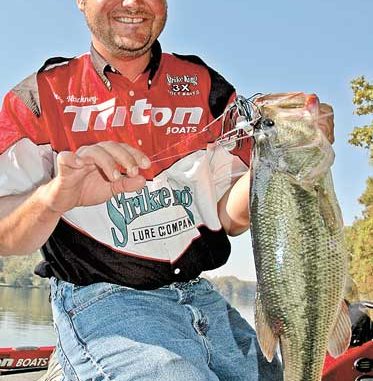
An American hero gets some respite – South Louisiana style!
May’s an excellent month to fish the Red River because the bass have finished their spawn and are starting to move from the bank out to deeper water. But they’re not all the way to the deep places where they tend to hold in the summertime.
The weather’s also warming up, and the bass are actively feeding to recover from the spawn.
The bass will hit buzz baits, crankbaits and spinnerbaits this month at the Red River. The water level will determine how and where I’ll fish because May can be a real mess for a bass fisherman if the water rises. However, even if the water’s high, you can get far enough away from the river and into the backwaters where you’ll locate clear water to fish.
Although many anglers don’t like to fish the Red River when it’s high, that’s when I prefer to fish there. The bass will be suspended back in the woods and under duckweed.
I’ll start the morning with a buzz bait or Strike King Rage Toad. I really prefer to fish baits that move a lot in May. Both the buzz bait and the Rage Toad have a lot of action, and I can move them fairly fast across the water. I like the Rage Toad because it’s similar to a buzz bait.
This month, a number of bass on the Red River will see buzz baits, and when they’re actively feeding, they’ll eat those buzz baits. Since the action on the Rage Toad (its ability to disturb the water) is on the back of the bait rather than the front, the bass won’t see as many Rage Toads as buzz baits, which often means they’ll eat it more readily. Also, the bass will eat the Rage Toad even when they’re not aggressively feeding.
I like to call the Rage Toad a silent buzz bait. The Rage Toad has a really subtle profile, and if you look at critters in the water, you’ll see that when they move across the surface of the water, whatever makes it move is generally in the back of its body and not the front. Therefore, the Rage Toad is more natural looking and imitates more different types of prey species when it moves across the surface of the water than the buzz bait does.
If you look at a buzz bait, you’ve really got to wonder, “Why in the world would a bass eat this?” A buzz bait doesn’t resemble any naturally occurring prey that the bass eats. The buzz bait does, however, give off a unique sound.
I can throw the Rage Toad hard against the surface of the water and skip it into lily pads, grass or any type of bush or tree, logjams, bushes or other types of cover where the bass may be suspended.
In May, the hotter the weather, the more actively the bass will be feeding on topwater baits, especially early in the morning. I don’t really try to spice up the colors of Rage Toad I fish. I like a white Rage Toad. If it’s cloudy, I’ll throw either black or junebug. If the water’s gin clear, I’ll fish watermelon-red. But under most conditions, I’ll be fishing white. I’ll throw the bait on 50-pound-test Cajun Braid line, which enables me to make long casts back into heavy cover.
Many times the bass will come up under the Rage Toad and actually bite the legs. If a big bass comes up and crushes that Rage Toad, it gets that entire bait in its mouth as soon as it takes the bait. But more than likely the bass will swim-up behind the Rage Toad and suck it in or attack it from behind, biting the legs, pulling the Toad down under the water and then swallowing it.
When fishing surface lures, most fishermen set their hooks on the strikes. Many times a bass will miss a surface lure like the buzz bait or the Rage Toad. I have a tendency to set the hook too quickly. To prevent from doing that, I hold my rod tip up at about an 11:00 or a 12:00 position. Then when the bass hits the lure, I’ll drop my rod tip, allowing slack in the line before I can set the hook. Bringing that rod tip down from the 11:00 position, reeling as you lower the rod tip, and then setting the hook works most of the time. Then you won’t reel in a legless Rage Toad.
At this time of year, I have days on the Red River where I’ll catch 20 to 25 bass. The Red’s fishing is probably in as good of shape as it’s ever been. The high water the last couple of years has made fishing the Red River somewhat difficult. The bass have gotten off a good spawn this year, and from what I learned while fishing the 2009 Bassmaster Classic there, a number of quality fish will be concentrated in the Red River this year.
In the last couple of years, the Red has produced 9- and 10-pound bass. During May, the Red River will be in its prime. In the past, anglers on the Red probably have caught more bass there than they will this May. However, more quality bass will be caught at the Red River this year than in the past several years.


